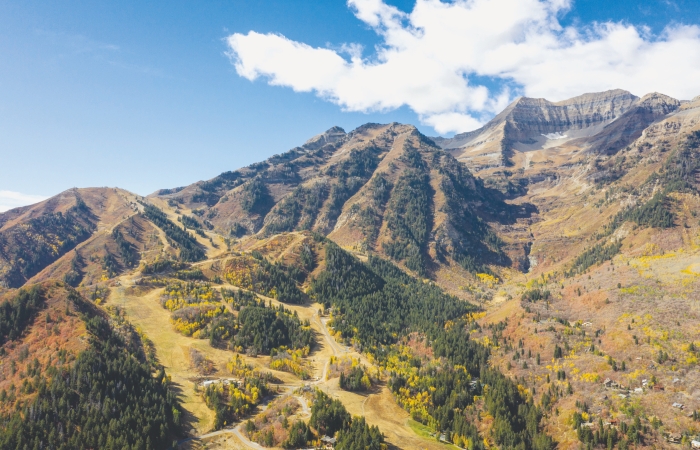This state in the Mountain West sub-region of the Western United States has 3.5 distinct geographic regions, five national parks, 45 state parks, five national historic sites and trails, and a dozen national monuments and recreation areas. With perfect powder, rugged red rock, alpine lakes, Utah has this and much more to offer to visitors.
It’s that time of the year to gear up! If hiking is the sport for you, Utah offers a trail with resplendent views, towering climbs and expansive rivers. This summer discover new paths and experience adventures that will rejuvenate your mind and body.
Hiking is no longer just a form of recreation, Utah the hidden gem in America offers every person a unique experience, right from navigating new trajectories, discovering waterfalls, camping under a starlit sky and waking up to a magnificent sunrise at some of the most jaw dropping sceneries, it could possibly be an ardent hiker’s dream destination!
There are thousands of miles of great hiking trails throughout Utah. Some trails are most well-suited to rugged, multi-day backpacking, but there are innumerable “out and back” and “loop” hikes ranging from quick trots to stunning formations, and moderate paths than can be done in a few hours to full-day explorations.
On a hike in Utah, you can stretch out at 13,000 feet above sea level and gaze out over alpine lakes and dense forests of pine and aspen thousands of feet below. Or, pull on shoes suitable for hiking in water and step into a stream for a journey through a mystical desert canyon with periodic swim breaks beneath beautiful waterfalls. Crane your neck as your pace slows, walk beneath natural bridges, and wonder what life must have been like for the Anasazi, who lived here a thousand years ago. Mentioned below is Utah’s curated list, specifically chalked out for passionate hikers.
The Narrows, Zion National Park
If there ever was a term for a perfect hike, Zion National Park should be high up there in any climbers bucket list. The hikes range from family friendly, moderate to intense. Whether it’s hiking, camping, canyoneering or simply driving, there is plenty of scenic beauty encompassing some dramatic desert landscape to take in at Zion National Park.
Zion National Park carries a reputation as a bucket list destination for adventurous trail seekers around the world. Here you can gaze down the commanding Zion Canyon from atop Angels Landing, reconnect with nature on a multi-day backpacking expedition or visit one of a kind destinations like Emerald Pools via easily accessed day hikes.
The best time to visit Zion National Park is between the months of April and November when the park’s free shuttles are running and the weather is comfortable.
Navajo Loop Trail, Bryce Canyon National Park
This rather short trail which offers a 1-hour to 2-hour loop from the rim at Sunset Point down to the floor of Bryce Canyon is perfectly carved out for a Marvel fan, displaying hoodoo formations such as Wall Street, Twin Bridges, and wait-for-it Thor’s Hammer!
A place where fantasy and reality collide, the path offers some iconic rock formations featuring Gulliver’s Castle, the Queen’s Castle, and Queen Elizabeth herself, a fascinating structure that rises 50 feet west of the junction at the end of the trail.
The Bryce Canyon National Park is a short trail descending below the canyon rim that takes hikers to interesting rock formations including Gulliver’s Castle, the Queen’s Castle and Queen Victoria. Best time to visit the place is between April and October.
Lower Calf Creek Falls, Grand Staircase-Escalante National Monument
Here’s one for the laidback climbers, the photographers, hikers that wish to be one with the ecosystem, Calf Creek Streaming down more than 100 feet along mineral-stained sandstone is a sight to behold, the waterfalls appears to radiate in its clarity.
While the path can get slightly tedious, it’s a perfect trail for families with enthusiastic children, the waterfall transforms into an absolutely awe-inspiring picnic spot for both adults and kids.
Calf Creek is a perennial stream located in the Grand Staircase-Escalante National Monument. There are two waterfalls that you can visit, the upper falls and the lower falls. Though both hikes are enjoyable, the lower falls is more accessible, an easier hike, a bigger drop, and much more popular. The 6-mile out-and-back hike is relatively flat, and the trailhead is located just off of Utah Scenic Byway 12, the highway between Escalante and Boulder. There is a sign for Bureau of Land Management (BLM) Calf Creek Recreation Area.
At the lower falls, a clear stream descends 126 feet into a pool, where folks take a swim. Mist from the falls and shade keep the haven cool even on the hottest of days. Aside from the falls, the trail offers several points of interest, all indicated with numbered posts along the trail and a handy guide that is picked up at the trailhead.
The feeling of craning your neck to view the top of the 126-foot falls; how the cool mist refreshes you after the long, hot hike down the path; you yelp as you dunk yourself into the cold, cold water; how you never wanted to hike back to the car. Who is going to love it? Kids and dogs will love the swim the most, and you can often hear children giggling and yelling with joy as you approach the falls. But, really, who doesn’t love looking at a majestic waterfall? This trail offers activities everyone can enjoy.
Buckskin Gulch Day Hike – Wire Pass Trailhead, Vermilion Cliffs Wilderness
Buckskin Gulch is renowned not only because of its continuous challenging narrows, but also because there is no other canyon like it in the world. Ideally considered a relatively easier hike, it’s also pet friendly (however, the dog needs to be on a leash).
For 12.5 miles the gulch is enveloped in a very narrow gorge 100 to 200 feet deep, flanked by vaulting convoluted walls of Navajo Sandstone. Now you can delve in its beauty with your pet by your side.
This trail is best enjoyed during April through early June and September through October and strictly avoided during rainfall.
Mount Timpanogos, Wasatch Mountain Range
Saving the best for the last is Mount Timpanogos. The word “Timpanogos” comes from the native Timpanogos tribe’s words for “rock” and “water,” although the hike falls under a strenuous category, the climb offers you some gorgeous panoramic views, stunning caverns, emerald lakes and glacial waterfalls (Fun Fact: It may not look like a typical glacier at first glance; that is because this is a rock glacier. The ice itself is buried underneath a hard crust of dirt and rock).
This leaves Mt. Timpanogos on an absolute must visit list, the most popular time is around May to October.
Here we have it all, a hikers guide through Utah. Don’t miss this opportunity to raise the bar this summer with a trail through some of Utah’s most infamous spots that have carved a path for both amateurs and professional hikers alike.
While Utah offers a multitude of hiking trails customised for your specific requirement, explore the offbeat tracks that may not be as popular as their counterparts but are known for its distinct characteristics:
- Hickman Bridge Trail, Capitol Reef National Park
- Little Wild Horse Canyon, San Rafael Swell
- Bell’s Canyon, Little Cottonwood Canyon, Salt Lake City
- Horseshoe Canyon to the Grand Gallery, North of Canyonlands National Park
Hickman Bridge Trail, Capitol Reef National Park
State Route 24 runs right through the middle of Capitol Reef National Park, giving you easy access to a total of 15 good day-hikes and plenty of adventures. While these are considered front-country hikes, it doesn’t take long to feel like you are in the middle of complete wilderness. An afternoon or day spent on the Hickman Bridge or Navajo Knobs trail is enough to seal Capitol Reef National Park into your memory forever.
Little Wild Horse Canyon, San Rafael Swell
The San Rafael Swell, a 70 by 40-mile geologic upheaval located in southeastern UT, has been cut, shaped and formed over thousands of years into a crazy assembly of sandstone buttresses, canyons and plateaus. The Northern Swell, located north of Interstate 70, offers fantastic hiking, backpacking, biking and camping at all levels of fun. The area offers a less crowded alternative for those who are willing to make the journey to the more remote spots on the map.
Bell’s Canyon, Little Cottonwood Canyon, Salt Lake City
Few places so near an urban area are so rich in diversity. Local residents of the Wasatch Front have all of this right here in our “backyard”. The granite cliffs are a paradise for both rock climbers and the mountain goats you might see as you drive the byway. Little Cottonwood Canyon is so named because its length and width are “littler” than its big neighbour to the north; however, it is an equally glorious natural playground. At the mouth of the canyon is the site where Mormon pioneers quarried massive granite blocks used to construct the Salt Lake Temple and the LDS Conference Center. The Uinta-Wasatch-Cache National Forest is the westernmost wall of
the Rockies.
Horseshoe Canyon to the Grand Gallery, North of Canyonlands National Park
Horseshoe Canyon is a remote section of Canyonlands National Park that was added in 1972. Formerly known as Barrier Canyon, this area is home to some of the most impressive rock art created by the ancient Barrier Culture. A journey through this desert region of mature cottonwoods, desert washes, and soaring sandstone cliffs is punctuated by massive rock art panels, including the Great Gallery, holding intricately created pictographs and petroglyphs.
Canyonlands National Park
Imagine endless deep canyons, towering mesas, pinnacles, cliffs, and spires stretching across 527 square miles. This is Canyonlands National Park, formed by the currents and tributaries of Utah’s Green and Colorado rivers. Canyonlands is home to many different types of travel experiences, from sublime solitude in the more remote stretches of the park to moderate hikes through the Needles district to the opportunity to create your own version of one of the West’s most photographed landforms, Mesa Arch. Do yourself a favour and don’t hurry through the park. Instead, take your time and let the nature of the Canyonlands sneak up on you and take root in your heart. It is quite likely you will become so attached to the place that you will have to return again and again and again.
Leave no stone unturned and no trail untouched. If America is your destination don’t miss out on these glorious trails in Utah. The key is simple, stay hydrated, carry your equipment and let nature lead the way.
 TravTalk India Online Magazine
TravTalk India Online Magazine







